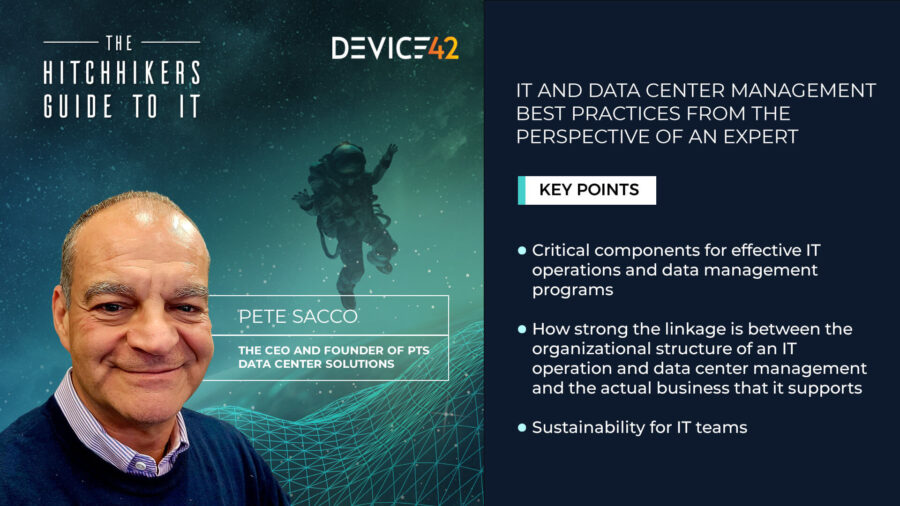This blog was created from a recent episode of Device42’s podcast, The Hitchhikers Guide to IT. You can find the latest episodes here.
The rapid evolution of the data center industry has given customers a wide array of options for how they enable and operate their businesses. Enterprises can run their own data centers to power core-to-edge networks, or they can partner with managed service, colocation, hyperscale, and cloud providers, exiting the data center business entirely. An astonishing 94% of organizations are operating a multi-cloud infrastructure in 2023.
So, what does the current state of IT operations and data center management look like today now that enterprise leaders and teams have adopted a cloud-first mentality?
In our first episode of The Hitchhikers Guide to IT, Host Michelle Dawn Mooney was joined by Pete Sacco, the CEO and Founder of PTS Data Center Solutions, to discuss how IT and data center management best practices are evolving to meet new industry requirements. The insightful discussion addressed what makes IT operations and data management programs effective, the linkage between the organizational structure of an IT operation and data center management and the actual business that it supports, and what sustainability looks like for IT organizations today.
Sacco founded PTS, a design-build services company for the data center industry, 23 years ago. PTS designs enterprise, co-location, and hyperscale facilities and provides customers with advisory services about which workloads to deploy to the cloud.
Sacco said that a hybrid data center economy is emerging, where enterprises use the best resources to achieve their goals. That may mean operating their own edge sites; leveraging colocation facilities, and migrating workloads to the public cloud, such as Amazon Web Services, Google Cloud Services, and Microsoft Azure.
While many companies are cloud-first, they are no longer cloud-only, said Sacco. That’s because on-site workloads support people, processes, and technologies; have to retain autonomy; and must continue operations in any condition. As a result, these workloads must maintain internet connection links to other data centers and other edge sites. That’s complicating data center management, stated Sacco, adding:
We’ve made data center operations extremely complex because it is complex. We have three major operating platforms, and everybody’s doing it slightly different[ly] and there’s no religion behind it. And so, what we’re seeing today is a much more complex, difficult to rein in, way more difficult to digitally secure … [the] hybrid environment. And what does that mean for the future? It means [data center operations] will continue to evolve.
Welcome to the Distributed Edge Revolution
Sacco said that the next data center revolution is occurring now, and it’s the evolution to the distributed edge. He joked that most big cloud data centers are in professional football cities, such as Denver, Los Angeles, New York, and Chicago. However, cloud and hyperscale providers need to bring capacity closer to the edge, or what Sacco called college football cities. These smaller-scale cities ring the larger cities, but still have significant commerce occurring there. As a result, they need the benefits of local cloud edge service, such as lower latency and faster processing speeds.
Read our blogs:
Edge Computing Versus Cloud Computing: Which is Right for Your Business?
Understanding the Impact of Edge Computing on Data Center Management
Edge data centers are smaller, more nimbly built, and less physically hardened than cloud and hyperscale facilities. But they’re incredibly resilient and provide enterprise teams with the ability to move data around. Said Sacco:
So, that’s how I believe we’re going to see a distributed edge. We’re going to be living with edge infrastructure for the long-term. It can’t go away because of performance, bandwidth requirements, autonomy, and a bigger scale of governance and security. So, we’re always going to have an edge requirement. The trick is now how do I balance that?
Determining Where Workloads Should Be Placed
Enterprise teams need to determine where workloads should reside: whether at the edge, in a location facility, or in the cloud. Sacco said that “The edge is where performance matters; …co-location is where aggregation of data takes place.” Colocation providers are connected to public cloud operators and provide elastic capacity that enables teams to do things like train deep learning models and create big-data analytics. As a result of their diverse capabilities, cloud, colocation, and edge computing will all continue to grow.
Solutions like Device42, which provides integrated CMDB, ITAM, and DCIM capabilities, helps teams make sense of IT complexity and determine the optimal placement of data workloads. Said Sacco:
We’re only going to get better … working with companies like Device42, [which provides] a toolset whereby we [can] go in, and we can map the workload not just from the physical asset. We want to go back into what is the function; what’s the workload; what application does it reside on; what application sits on what hardware from compute storage, virtual server and network? What are the interconnections between those [assets]? How do those [assets] map to power distribution? How do [they] map to space inside my cabinets, my pods, my rows, my entire data center? And how do [they] map to the cooling and the other things that I need in the data center facility?
The Link Between IT Operations and the Business It Supports
Mooney and Sacco tackled the next topic: how tight the link is between the organizational structure of an IT operations and or data center management and the business that it supports.
Sacco said that it’s strong, but not recognized enough. Large organizations use IT service management (ITSM) functions to strengthen this linkage, provide exceptional service to the business, and ensure accountability for maintaining infrastructure and application uptime and performance. Small and medium-sized businesses struggle with this responsibility, as they lack the resources and talent of their larger peers. However, they can tap digital software and third-party expertise to bolster IT performance and cybersecurity.
A Forrester survey found that 78% of IT organizations have a defined incident management process. Among this group, 38% use a formal tool and 37% use swarming processes to guide incident analysis and resolution. One interesting – and contradictory – statistic is that 67% of these organizations have a CMDB, but 91% believe that this tool is essential to improving ITSM operations. That likely means that many IT teams are evaluating CMDB solutions and plan to purchase one in the near future.
Sacco said he’s heartened by the rise of Generation Z IT talent, who he believes will automate key IT workflows and structures, improving enterprise IT operations further. Gen Z has a strong interest in IT, as evidenced by the 38% growth in college students graduating with degrees in computer and information science and the 19% growth in those earning engineering degrees, when comparing cohorts in 2015-2016 and 2018-2019. That means that enterprise IT leaders will have a deeper talent bench to access moving forward.
Read our blogs:
How to Improve Incident Management and Minimize Business Risk
How to Improve Your IT Incident Management Processes
IT’s Role in Auditing and Ensuring Compliance for Sustainability
The conversation turned again, this time to sustainability. IT can play a valuable role in helping improve the governance, control, and auditing of sustainability processes. Sacco said that his generation was excited to automate processes and prioritizes issues such as increasing functionality and resiliency over sustainability. Younger leaders and teams are more aware of climate change, with related environmental impacts and resource constraints. As a result, they are striving to future-proof business models and processes by making them more sustainable.
The definition of sustainability is changing in the data center industry. Early proponents claimed that going cloud-first would increase customer sustainability. However, that’s only true if data centers are built to be efficient, with leading-edge IT equipment, airflow, power, and cooling, as well as teams that are committed to continuously optimizing processes.
PTC has redesigned greenfield data centers from the ground up to meet customers’ needs for more efficient, sustainable processes. PTC’s new data center design, Reimagined 2.0, can be used for facilities using one megawatt of power up to “infinite scale,” said Sacco. PTC can also modify existing “brown” facilities to make them more sustainable. Design and build costs can be up to 30% cheaper than what could have been achieved 10 years ago, stated Sacco, although supply chain issues may erode some of these savings.
Learn more by reading our blogs:
Increasing Data Center Energy Sustainability: Short- and Long-Term Strategies
How data centers can use renewable energy to increase sustainability and reduce costs
A Move to Distributed Energy
So, what’s next with data center energy consumption? Mooney asked Sacco.
Industry trends, such as distributed workforces, electric and autonomous vehicles, big-data analytics, and systems of intelligence will require more power than ever. Global electricity demand is slated to increase at 3% over the 2023 to 2025 timeframe.
So, how can data center leaders prepare for this transition?
Data centers are moving to a distributed energy play, said Sacco. The growth of renewables means that green energy will meet 35% of all global power generation needs by 2025. Sacco stated:
We will [use]… hydrogen fuel cells, create electricity on-site, combine that with wind, combine that with solar, combine it with the electric utility, combine it into a micro grid and then deliver it in a highly resilient, cost-effective manner. And it is going to be the only way.
Leading Data Center Companies at a Time of Uncertainty
Economic volatility, fast-paced cloud migrations, sustainability pressures, and other developments are making this a challenging and exciting time to be an IT leader. Sacco said that the enterprise C-suite’s enthusiasm for going cloud-first is being tempered by the lack of significant savings they’ve achieved. Cloud services are expensive and overprescribed, resulting in underutilized assets and soaring costs. Instead, teams should think strategically about their workloads and where to place them. Said Sacco:
The problem is for the IT manager to think about [cloud services] holistically and start by mapping what your workloads are and what their interdependencies are. How are you going to manage that lifecycle in a series of glued-together, highly integrated software [solutions] that make sense?
Companies can use solutions like Device42 to discover applications and map their dependencies, manage physical and digital infrastructure on a single platform, and integrate with their ITSM stack to improve governance, control, and configuration. Databases should be managed as one integrated stack, stated Sacco.
So that as we have to move workloads either from the distributed edge physical world to the co-location semi-physical world to the cloud world where it’s all digital, we have [a roadmap] to say what will be impacted and how and how do we do that most effectively.
By taking this approach, companies can automate as much as possible to reduce resource use and infrastructure complexity. Sacco cautioned enterprise IT leaders to move away from the belief that “one model, onsite co-location cloud fits everything.”
You’re going to be forced to learn how to manage in a hybrid environment and then layer a very complex digital security platform over the top of all of that and then use an ITSM and discovery tool in perpetuity to manage all of those pieces.
That’s great advice. Thanks to host Michelle Dawn Mooney and guest Pete Sacco for their insights and desire to help IT leaders prepare for what’s coming next. Stay tuned for future episodes of the Hitchhikers Guide to IT to hear more thought leadership on data center trends from other industry leaders.
If you’d like to manage hybrid cloud infrastructures with greater clarity and less work strain, Device42 can help. You can use the insights our tool provides to reduce infrastructure complexity and improve the performance of all your data center assets.




